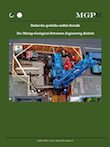Pressure build-up test analysis of the reservoir system with the multiphase flow
DOI:
https://doi.org/10.17794/rgn.2018.3.8Keywords:
multiphase flow, pressure transient analysis, reservoir permeability, well testingAbstract
The present work focuses on the determination of absolute permeability in an oil reservoir whose pressure is under the bubble point. The simulation of the reservoir and well with the simultaneous flow of oil and gas is performed using the Eclipse100 software. The main purpose of the simulation is to obtain pressure build-up tests for two reservoir systems, as the well testing technology requires the shut-in period, which increases the costs of the real well production cycle. In the first simulation it is presumed that the well is not damaged, having the skin effect equal to zero, while in the second one, the skin effect of the well in the same reservoir is 9,44. The aim is to compare the results of the pressure build-up test analysis for both cases. In each case, permeability is firstly calculated using four methods, given by different authors. The theoretical background and the process of obtaining the required results are given for each approach. Results are compared with the permeability as determined by the pressure transient analysis, using the Saphir software, for both the ideal and the damaged well. Differences in results are presented and discussed. Conclusions can be applied to real reservoir systems with the multiphase fluid flow in the porous media.
Downloads
Published
How to Cite
Issue
Section
License
Copyright (c) 2018 Rudarsko-geološko-naftni zbornik

This work is licensed under a Creative Commons Attribution 4.0 International License.
Creative Commons-BY
Authors who publish with this journal agree to the following terms:
In agreeing this form, you certify that:
- You read the ethical codex of the RGN zbornik available at journal web.
- You submitted work is your original work, and has not previously been published and does not include any form of plagiarism.
- You own copyright in the submitted work, and are therefore permitted to assign the licence to publish to RGN zbornik.
- Your submitted work contains no violation of any existing copyright or other third party right or any material of an obscene, libellous or otherwise unlawful nature.
- You have obtained permission for and acknowledged the source of any illustrations, diagrams or other material included in the work of which you are not the copyright owner.
- You have taken due care to ensure the accuracy of the work, and that, to the best of your knowledge, there are no false statements made within it.
- All co-authors of this submitted work are aware of, and in agreement with, the terms of this licence and that the submitted manuscript has been approved by these authors.
Publication licence
You retain copyright in your submitted work, according to journal license policy (CC-BY). By signing this form you agree that RGN zbornik may publish it under the publication licence. In summary the licence allows the following:
Anyone is free:
- To copy, distribute, display, and perform the work.
- To make derivative works.
Under the following conditions:
- The original author must always be given credit.
- The work may not be used for commercial purposes.
- If the work is altered, transformed, or built upon, the resulting work may only be distributed under a licence identical to this one.
Exceptions to the licence
In addition to publishing the work printed under the above licence, RGN zbornik will also enable the work to be visible online.
The journal editorial can change the licence rules anytime but it cannot retroactively restrict author(s) rights.


